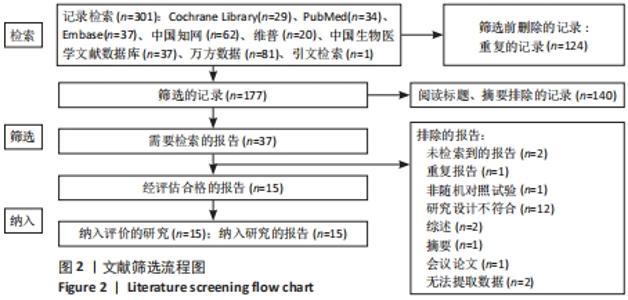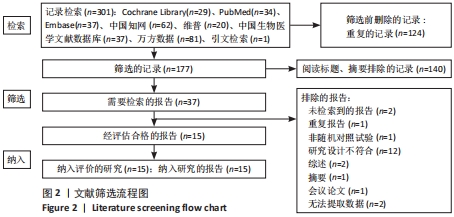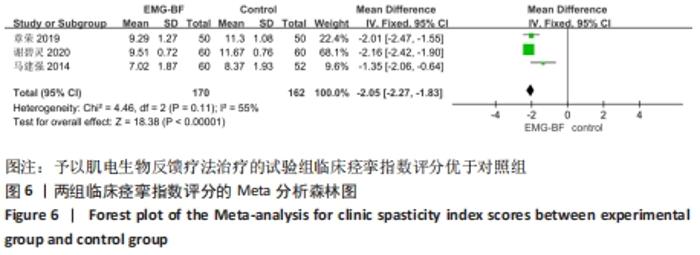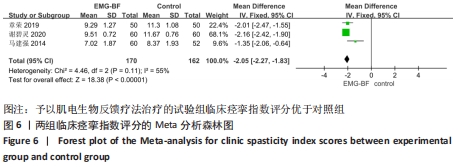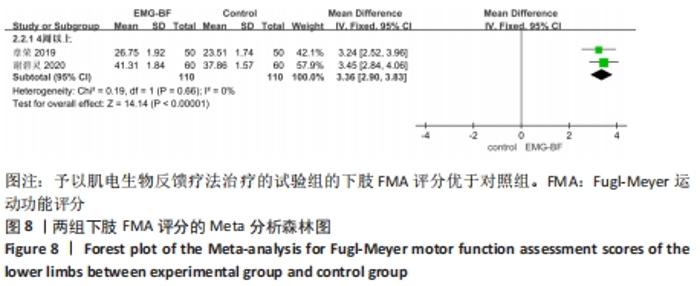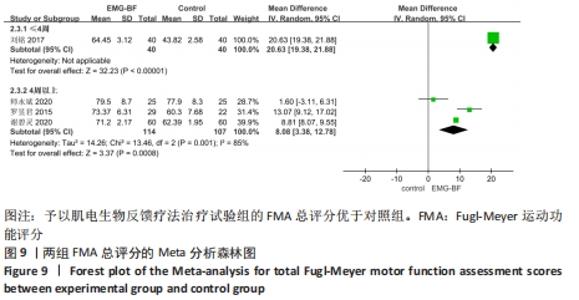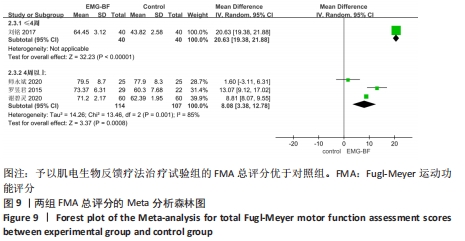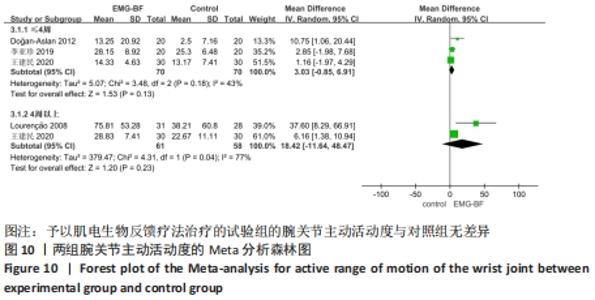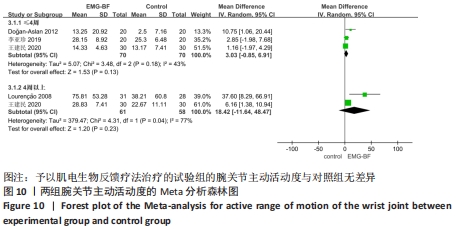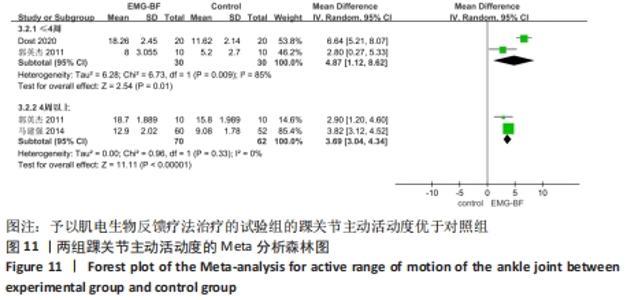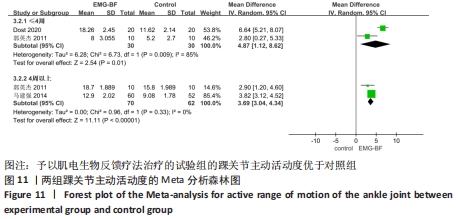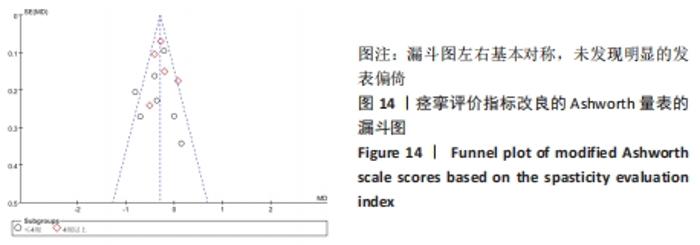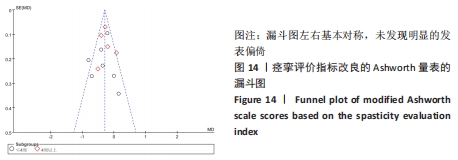Chinese Journal of Tissue Engineering Research ›› 2022, Vol. 26 ›› Issue (29): 4742-4748.doi: 10.12307/2022.899
Previous Articles Next Articles
Electromyographic biofeedback for post-stroke limb spasticity: a Meta-analysis
Zhang Tiantian1, Li Jiamin1, Ou Liang2, Shang Yan1, Xu Yaqian3, Hu Guoheng1, 3
- 1Graduate School, Hunan University of Chinese Medicine, Changsha 410208, Hunan Province, China; 2Department of Orthopedics, the Second Affiliated Hospital of Guizhou University of Traditional Chinese Medicine, Guiyang 550001, Guizhou Province, China; 3Department of Neurology, the First Hospital of Hunan University of Chinese Medicine, Changsha 410007, Hunan Province, China
-
Received:2021-09-10Accepted:2021-10-28Online:2022-10-18Published:2022-03-28 -
Contact:Hu Guoheng, MD, Professor, Chief physician, Graduate School, Hunan University of Chinese Medicine, Changsha 410208, Hunan Province, China; Department of Neurology, the First Hospital of Hunan University of Chinese Medicine, Changsha 410007, Hunan Province, China -
About author:Zhang Tiantian, MD candidate, Physician, Graduate School, Hunan University of Chinese Medicine, Changsha 410208, Hunan Province, China -
Supported by:the National Natural Science Foundation of China, No. 81573941 (to HGH)
CLC Number:
Cite this article
Zhang Tiantian, Li Jiamin, Ou Liang, Shang Yan, Xu Yaqian, Hu Guoheng. Electromyographic biofeedback for post-stroke limb spasticity: a Meta-analysis[J]. Chinese Journal of Tissue Engineering Research, 2022, 26(29): 4742-4748.
share this article
Add to citation manager EndNote|Reference Manager|ProCite|BibTeX|RefWorks
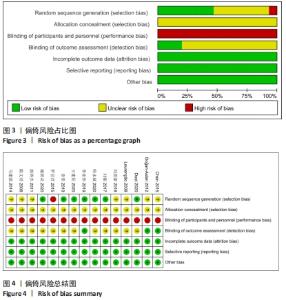
2.2 纳入研究的方法学质量评价 纳入的15项研究均报道了组间基线资料的可比性。有14项研究提及了“随机”分配[19-22,24-33],并有7项研究提及了随机数字表法产生随机序列[26,28-33];研究均未具体描述分配序列隐藏方案;因操作限制,受试者盲法难以完成,故实施过程偏倚均判定为高风险,3项研究提及测量过程盲法[22,24,29];6项研究通过了伦理委员会伦理审查[19,28,30-33],10项研究提及签署了知情同意书[19,21,25-26,28-33],纳入研究均未发现存在研究结果数据不完整、选择性报告研究结局及其他偏倚来源的情况。Jadad评分高质量文献9篇[22,24,26,28-33],低质量文献6篇[19-21,23,25,27]。具体的风险偏倚评估结果见表1,图3和4。"
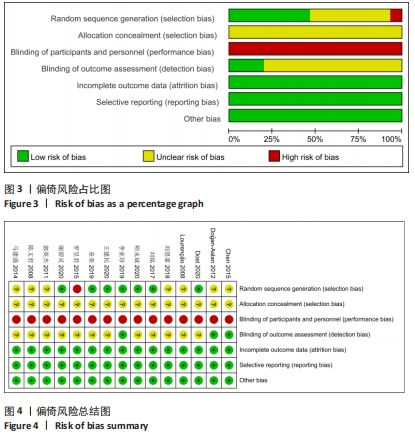
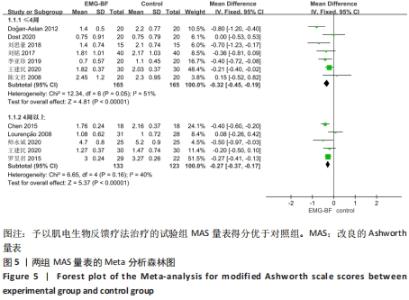
2.3 Meta分析结果 2.3.1 痉挛程度评定 在纳入的15项研究中,报道了2种痉挛评定量表,分别是MAS量表及临床痉挛指数。其中,12项研究报道了MAS评分[19-22,24-27,29-30,32-33],1项研究因原始数据为区间数值无法计算故未纳入定量分析[21]。其中,7项研究报道了肌电生物反馈治疗时间≤4周的MAS[20,22,26-27,29-30,32],提示试验组MAS评分优于对照组,具有统计学意义(MD=-0.32,95%CI:-0.45至-0.19,P < 0.000 01),如图5所示。由于研究结果间存在显著异质性(I2=51%,P=0.05),经逐一剔除研究进行敏感性分析后,提示剔除DO?AN-ASLAN等[22]研究后研究间异质性明显降低(I2=20%,P=0.28),且试验组MAS评分仍优于对照组,具有统计学意义(MD=-0.26,95%CI:-0.40至-0.13,P=0.000 2)。5项研究报道了肌电生物反馈治疗时间在4周以上的MAS[19,24-25,32-33],结果显示试验组MAS评分优于对照组,具有统计学意义(MD=-0.27,95%CI:-0.37至-0.17,P < 0.000 01),研究间异质性在可接受范围内,见图5。"

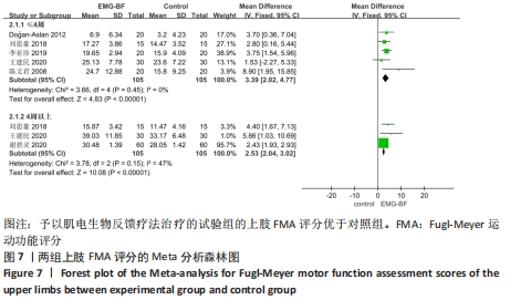
2.3.2 FMA运动功能评分 5项研究报道了肌电生物反馈治疗时间≤4周的上肢FMA评分[20,22,27,29,32],提示试验组对上肢运动功能改善优于对照组,具有统计学意义(MD=3.39,95%CI:2.02-4.77,P < 0.000 01),研究间同质性较好(I2=0%,P=0.45)。3项研究报道了肌电生物反馈治疗时间在4周以上的上肢FMA评分[27,31-32],试验组对上肢运动功能改善优于对照组,具有统计学意义(MD=2.53,95% CI:2.04-3.02,P < 0.000 01),研究间异质性在可接受范围内(I2=47%,P=0.15)。见图7。2项研究报道肌电生物反馈治疗4周以上的下肢FMA评分[28,31],试验组对下肢运动功能改善优于对照组,具有统计学意义(MD=3.36,95% CI:2.90-3.83),P < 0.000 01),研究间同质性较好(I2=0%,P=0.66)。见图8。"
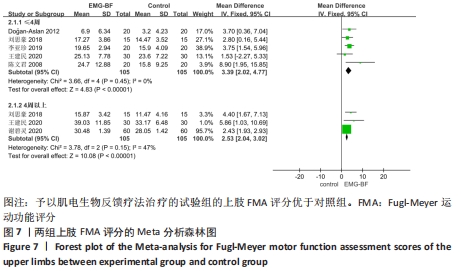
| [1] NAGHAVI M, ABAJOBIR AA, ABBAFATI C, et al. Global, regional, and national age-sex specific mortality for 264 causes of death, 1980-2016: a systematic analysis for the Global Burden of Disease Study 2016. Lancet. 2017;390(10100): 1151-1210. [2] GBD 2016 NEUROLOGY COLLABORATORS. Global, regional, and national burden of neurological disorders, 1990-2016: a systematic analysis for the Global Burden of Disease Study 2016. Lancet Neurol. 2019;18(5):459-480. [3] JOHNSON W, ONUMA O, OWOLABI M, et al. Stroke: a global response is needed. Bull World Health Organ. 2016;94(9):634. [4] ZOROWITZ RD, GILLARD PJ, BRAININ M. Poststroke spasticity: sequelae and burden on stroke survivors and caregivers. Neurology. 2013;80(3 Suppl 2): S45-S52. [5] OPHEIM A, DANIELSSON A, ALT MM, et al. Upper-limb spasticity during the first year after stroke: stroke arm longitudinal study at the University of Gothenburg. Am J Phys Med Rehabil. 2014;93(10):884-896. [6] GILLARD PJ, SUCHAREW H, KLEINDORFER D, et al. The negative impact of spasticity on the health-related quality of life of stroke survivors: a longitudinal cohort study. Health Qual Life Outcomes. 2015;13:159. [7] LI S, CHEN YT, FRANCISCO GE, et al. A Unifying Pathophysiological Account for Post-stroke Spasticity and Disordered Motor Control. Front Neurol. 2019;10:468. [8] FRANCISCO GE, BALBERT A, BAVIKATTE G, et al. A practical guide to optimizing the benefits of post-stroke spasticity interventions with botulinum toxin A: An international group consensus. J Rehabil Med. 2021;53(1):m134. [9] SANTAMATO A, CINONE N, PANZA F, et al. Botulinum Toxin Type A for the Treatment of Lower Limb Spasticity after Stroke. Drugs. 2019; 79(2):143-160. [10] BETHOUX F. Spasticity Management After Stroke. Phys Med Rehabil Clin N Am. 2015;26(4):625-639. [11] 张通,赵军.中国脑卒中早期康复治疗指南[J].中华神经科杂志,2017,50(6):405-412. [12] 王丽菊,陈立早,欧艺,等.镜像视觉反馈和肌电生物反馈对脑卒中偏瘫患者上肢功能的影响[J].中国康复理论与实践,2015,21(2):202-206. [13] 何玲燕,吴月峰,王雪飞,等.穴位肌电生物反馈治疗脑卒中偏瘫后踝关节活动障碍的临床疗效观察[J].中国康复医学杂志,2020,35(11):1342-1345. [14] CUMPSTON M, LI T, PAGE MJ, et al. Updated guidance for trusted systematic reviews: a new edition of the Cochrane Handbook for Systematic Reviews of Interventions. Cochrane Database Syst Rev. 2019;10:D142. [15] PAGE MJ, MCKENZIE JE, BOSSUYT PM, et al. The PRISMA 2020 statement: an updated guideline for reporting systematic reviews. BMJ. 2021;372:n71. [16] THE WORLD HEALTH ORGANIZATION. Stroke--1989. Recommendations on stroke prevention, diagnosis, and therapy. Report of the WHO Task Force on Stroke and other Cerebrovascular Disorders. Stroke. 1989;20(10): 1407-1431. [17] HIGGINS JP, ALTMAN DG, GOTZSCHE PC, et al. The Cochrane Collaboration’s tool for assessing risk of bias in randomised trials. BMJ. 2011;343:d5928. [18] JADAD AR, MOORE RA, CARROLL D, et al. Assessing the quality of reports of randomized clinical trials: is blinding necessary? Control Clin Trials. 1996;17(1):1-12. [19] LOURENÇÃO MI, BATTISTELLA LR, DE BRITO CM, et al. Effect of biofeedback accompanying occupational therapy and functional electrical stimulation in hemiplegic patients. Int J Rehabil Res. 2008;31(1):33-41. [20] 陈文君,李建华,寿依群,等.表面肌电生物反馈治疗对偏瘫患者上肢功能的影响[J].中华物理医学与康复杂志,2008,30(8):548-550. [21] 郭英杰,程杨,丁华,等.生物反馈结合运动训练对脑卒中足下垂患者踝关节运动能力的影响[J].生物医学工程与临床,2011,15(2):125-128. [22] DOĞAN-ASLAN M, NAKIPOĞLU-YÜZER GF, DOĞAN A, et al. The Effect of Electromyographic Biofeedback Treatment in Improving Upper Extremity Functioning of Patients with Hemiplegic Stroke. J Stroke Cerebrovasc Dis. 2012;21(3):187-192. [23] 马建强.肌电生物反馈联合运动疗法对脑卒中跖屈肌痉挛的疗效观察[J].中国康复,2014, 29(3):212-213. [24] CHEN HX, WANG W, XIAO HQ, et al. Ultrasound-guided botulinum toxin injections and EMG biofeedback therapy the lower limb muscle spasm after cerebral infarction. Eur Rev Med Pharmacol Sci. 2015;19(9):1696-1699. [25] 罗昱君.推拿结合肌电生物反馈治疗脑卒中后上肢痉挛性偏瘫的临床观察[D].武汉:湖北中医药大学针灸推拿学,2015. [26] 刘铭,李芝慧,马晖.电子生物反馈疗法联合康复训练治疗脑卒中偏瘫痉挛对肌张力及运动能力的影响[J]. 实用中医药杂志,2017,33(10): 1114-1116. [27] 刘思豪,李哲,刘骞豪,等.低频重复经颅磁刺激联合肌电生物反馈疗法对脑卒中患者上肢功能的临床研究[J].中国康复,2018,33(6):451-454. [28] 章荣,叶陈,周蜜娟.肌电生物反馈疗法在脑卒中偏瘫异常步态患者中的应用研究[J].川北医学院学报,2019,34(4):445-447. [29] 李亚珍.手连续被动运动结合肌电生物反馈疗法对急(亚急)性脑卒中后手功能影响的研究[D].兰州:甘肃中医药大学,2019. [30] DOST SÜRÜCÜ G, TEZEN Ö. The effect of EMG biofeedback on lower extremity functions in hemiplegic patients. Acta Neurol Belg. 2020; 121(1):113-118. [31] 谢碧灵,邹沁,田玉.肌电生物反馈联合康复训练对脑卒中偏瘫患者运动功能和生活质量的临床研究[J]. 川北医学院学报,2020,35(2):350-353. [32] 王建民,王岳,厉坤鹏,等.肌电生物反馈治疗早期脑梗死后手腕部痉挛状态的疗效观察[J].中华物理医学与康复杂志,2020,42(8):709-711. [33] 师永斌,宋丹彤,张雁儒,等.肌电生物反馈疗法联合PNF训练对卒中患者肢体功能恢复的影响[J].中华物理医学与康复杂志,2020,42(10): 926-928. [34] LI S, FRANCISCO GE. New insights into the pathophysiology of post-stroke spasticity. Front Hum Neurosci. 2015;9:192. [35] PUNDIK S, MCCABE J, SKELLY M, et al. Association of spasticity and motor dysfunction in chronic stroke. Ann Phys Rehabil Med. 2019;62(6):397-402. [36] PICELLI A, TAMBURIN S, GAJOFATTO F, et al. Association between severe upper limb spasticity and brain lesion location in stroke patients. Biomed Res Int. 2014;2014:162754. [37] ZHANG B, SAATMAN KE, CHEN L. Therapeutic potential of natural compounds from Chinese medicine in acute and subacute phases of ischemic stroke. Neural Regen Res. 2020;15(3):416-424. [38] WISSEL J, VERRIER M, SIMPSON DM, et al. Post-stroke spasticity: predictors of early development and considerations for therapeutic intervention. PM R. 2015;7(1):60-67. [39] 王庭槐,高庆春,许小洋,等.肌电生物反馈的非线性机制[J].中国心理卫生杂志,2006(2): 113-117. [40] 刘美快,徐乐义,李海燕,等.肌电生物反馈疗法改善脑卒中患者腓肠肌形态结构的超声研究[J].中国康复医学杂志,2020,35(7):847-850. [41] 汪菲,何晴,李建华.表面肌电在中枢神经系统疾病肌痉挛患者评价中的研究现状[J].中国康复医学杂志,2016,31(11):1277-1280. |
| [1] | Wu Liang, Wang Qiang, Wang Wenbo, Xin Tianwen, Xi Kun, Tang Jincheng, Xu Jingzhi, Chen Liang, Gu Yong. Risk factors for traumatic central cord syndrome underlying with cervical spondylotic myelopathy [J]. Chinese Journal of Tissue Engineering Research, 2022, 26(9): 1388-1394. |
| [2] | Zhuang Zhikun, Wu Rongkai, Lin Hanghui, Gong Zhibing, Zhang Qianjin, Wei Qiushi, Zhang Qingwen, Wu Zhaoke. Application of stable and enhanced lined hip joint system in total hip arthroplasty in elderly patients with femoral neck fractures complicated with hemiplegia [J]. Chinese Journal of Tissue Engineering Research, 2022, 26(9): 1429-1433. |
| [3] | Jing Jinpeng, Zhang Yue, Liu Xiaomin, Liu Yi. Traditional Chinese medicine injection for promoting blood circulation in prevention of deep vein thrombosis after orthopedic surgery: network meta-analysis [J]. Chinese Journal of Tissue Engineering Research, 2022, 26(9): 1467-1476. |
| [4] | Tang Wenjing, Wu Siyuan, Yang Chen, Tao Xi. Inflammatory responses in post-stroke depression [J]. Chinese Journal of Tissue Engineering Research, 2022, 26(8): 1278-1285. |
| [5] | Liu Gang, Ma Chao, Wang Le, Zeng Jie, Jiao Yong, Zhao Yi, Ren Jingpei, Hu Chuanyu, Xu Lin, Mu Xiaohong. Ankle-foot orthoses improve motor function of children with cerebral palsy: a Meta-analysis based on 12 randomized controlled trials [J]. Chinese Journal of Tissue Engineering Research, 2022, 26(8): 1299-1304. |
| [6] | Yang Shenglin, Pu Xingwei, Luo Chunshan, Yang Jianwen. Neuroprotective effects of tetrandrine preconditioning in rabbits with spinal cord ischemia-reperfusion injury [J]. Chinese Journal of Tissue Engineering Research, 2022, 26(8): 1223-1227. |
| [7] | Zhao Jing, Liu Xiaobo, Zhang Yue, Zhang Jiaming, Zhong Dongling, Li Juan, Jin Rongjiang. Visualization analysis of neuromuscular electrical stimulation therapy based on CiteSpace: therapeutic effects, hot spots, and developmental trends [J]. Chinese Journal of Tissue Engineering Research, 2022, 26(8): 1234-1241. |
| [8] | Fang Xiaolei, Leng Jun, Zhang Chen, Liu Huimin, Guo Wen. Systematic evaluation of different therapeutic effects of mesenchymal stem cell transplantation in the treatment of ischemic stroke [J]. Chinese Journal of Tissue Engineering Research, 2022, 26(7): 1085-1092. |
| [9] | Yang Yang, Li Naxi, Zhang Jian, Wang Mian, Gong Taifang, Gu Liuwei. Effect of tourniquet combined with exsanguination band use on short-term lower extremity venous thrombosis after knee arthroscopy [J]. Chinese Journal of Tissue Engineering Research, 2022, 26(6): 898-903. |
| [10] | Lu Qinxue, Xu Ning, Yang Yinglan, Han Qianqian, Duanmu Xianyu, Guo Yuwei, Han Qing. Femoroacetabular impingement: strength trainings for nerve-muscle, peripheral muscle and core muscle [J]. Chinese Journal of Tissue Engineering Research, 2022, 26(5): 786-791. |
| [11] | Liu Yiyi, Qiu Junqiang, Yi Longyan, Zhou Cailiang. Effect of resistance training on interleukin-6 and C-reactive protein in middle-age and elderly people: a Meta-analysis [J]. Chinese Journal of Tissue Engineering Research, 2022, 26(5): 804-812. |
| [12] | Wang Nan, Qian Yuzhang, Xie Lin. Network Meta-analysis of different acupuncture methods for the treatment of lumbar disc herniation [J]. Chinese Journal of Tissue Engineering Research, 2022, 26(5): 813-820. |
| [13] | Fan Jianchao, Xu Paidi, Han Yongli, Wen Caiyuzhu, Zhang Hongxing, Pan Xiaoli. Effects of electroacupuncture at Zusanli acupoint on visceral hypersensitivity in rats with functional dyspepsia [J]. Chinese Journal of Tissue Engineering Research, 2022, 26(5): 663-668. |
| [14] | Wei Zhoudan, Li Wenjin, Zhu Li, Wang Yu, Zhao Jiaoyang, Chen Yanan, Guo Dong, Hao Min. Platelet-rich fibrin as a material for alveolar ridge preservation significantly reduces the resorption of alveolar bone height and width after tooth extraction: a meta-analysis [J]. Chinese Journal of Tissue Engineering Research, 2022, 26(4): 643-648. |
| [15] | Ou Liang, Kong Dezhong, Xu Daoqing, Ni Jing, Fu Xingqian, Huang Weichen. Comparative clinical efficacy of polymethyl methacrylate and self-solidifying calcium phosphate cement in vertebroplasty: a meta-analysis [J]. Chinese Journal of Tissue Engineering Research, 2022, 26(4): 649-656. |
| Viewed | ||||||
|
Full text |
|
|||||
|
Abstract |
|
|||||


